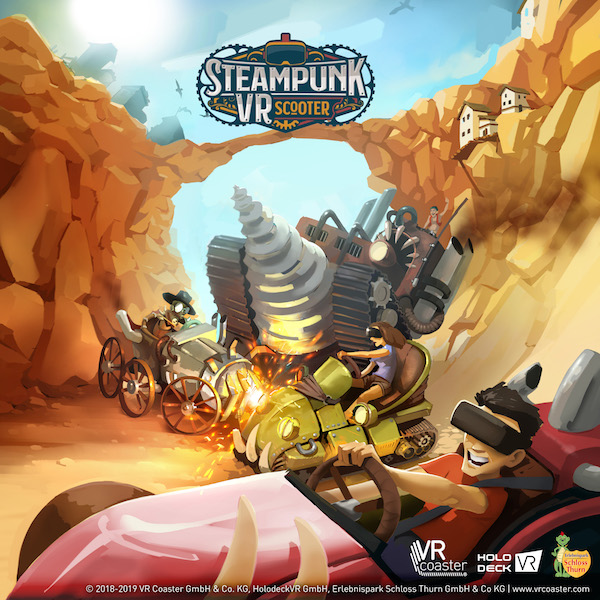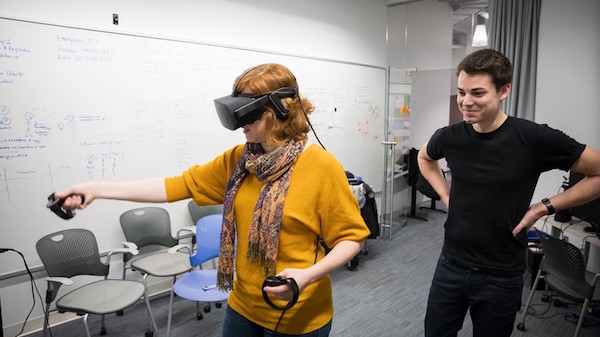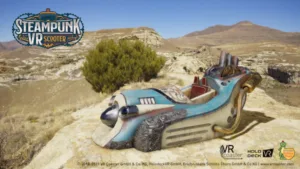In my last article I wrote about the new virtual reality bumper car ride( VR Bumper Cars are Coming!). While I didn’t get any response in time for the article from the makers, they did send me some artist renderings on what the ride will look on the inside. Overall, it’s a pretty cool look.

Steampunk VR scooter credit: Holodeck VRThe remaining questions about any kind of entertainment like this are about the usability as well as safety for the users. Since the real drive surface for the bumper cars is limited in size, the VR environment has to reflect these dimension as well. This may make for pretty tight quarters in which to maneuver the bumper car.
 Steampunk VR scooter credit: Holodeck VR
Steampunk VR scooter credit: Holodeck VR
We know from other VR applications that fast movements in the content, in combination with certain visual artifacts from the headset display, may trigger a kind of motion sickness in the user. In this case the movement, is not only within the content, but there is also a moving vehicle in the real world. Acceleration in bumper cars is not really high, but can be very high in the case of two vehicles hitting each other. This is kind of the idea of bumper cars in the first place. Folding this into the gameplay where physical interaction is mixed with virtual reality, one has to make sure that all these interactions do not confuse the user’s brain more than usual.
This is where the experience and technology of Holodeck VR and VR Coaster come into play. They have installed other VR games and entertainment venues where these questions also exist. This may very well be the next step in location-based VR entertainment.
Besides this short update to my last article I want to look at other non-consumer applications for VR. One that comes immediately into mind is in the area of training and learning. While we cover use of virtual reality technology in schools frequently, I want to present a new study from Cornell University in the area of university training. Cornell created a VR program for an introductory course in astronomy. Specifically they looked at how to teach a college student at the Cornell University the in and outs of the moon phases in VR.
 Jack Madden, doctoral candidate in the field of astronomy, watches as Andrea Stevenson Won, assistant professor of communication and director of the Virtual Embodiment Lab, uses a virtual reality simulator. Credit: Cornell University
Jack Madden, doctoral candidate in the field of astronomy, watches as Andrea Stevenson Won, assistant professor of communication and director of the Virtual Embodiment Lab, uses a virtual reality simulator. Credit: Cornell University
The interesting part is that they looked at how different teaching approaches influenced the learning success of the students. Since this topic has been taught to generations of astronomy students, they used different methods to teach the subjects. One was to use a hands-on approach with a light and a ball representing the moon. Moving around their own axes, the students learn the illumination patterns by direct observation. The second method is a computer simulation method and the third method is the new VR method.
The study was performed by Cornell students under the supervision of the department of astrology and the the Virtual Embodiment Lab. For the survey they divided the students into three groups and taught the subject with a follow up test to see what the students learned. The good news is that VR works in such a teaching environment; the bad news is that it does not work any better than the other methods. That is somewhat of a surprising result. The initial idea was that the higher immersiveness of VR will lead to better retention, however they could not confirm this in this particular study. I am sure they will work on other programs to see what works and what doesn’t.
Here is my issue with the approach. People have different ways of learning. Some people learn best with a textbook, while other need to see and or feel something to maximize their learning potential. In other words, what works well for one student may not work as well for othesr. Depending on the selection of students such studies maybe able to create misleading results at best.
When we talk about teaching we normally think about K to12 or maybe college students. But what about training at a later stage? For example you come out of college and have your masters degree in any subject, now you have to learn the real life use of your subject, whatever that maybe. You are a lawyer now, would you be able to defend someone in criminal case? You are a technician or engineer, you still have to learn the specifics of your first job. This learning stage is tough and requires on the job training. Maybe, here the VR approach could lead to faster and as a consequence more cost effective learning.
The extreme case in these applications is the training for dangerous situations. For example military, police, fire and rescue missions could be simulated and may very well the chances of success. These kind of extreme training scenarios are already being implemented as shown in the article of the CTIF (International Association of Fire and Rescue Services). Now add this to a simulation system that allows first responders to review the situation in VR on their way to the rescue site and you can see how this technology may change these fields for ever.
Overall I believe that the potential of virtual reality in these fields is much larger than the current applications suggest. Overall I believe that this is good thing. – NH

